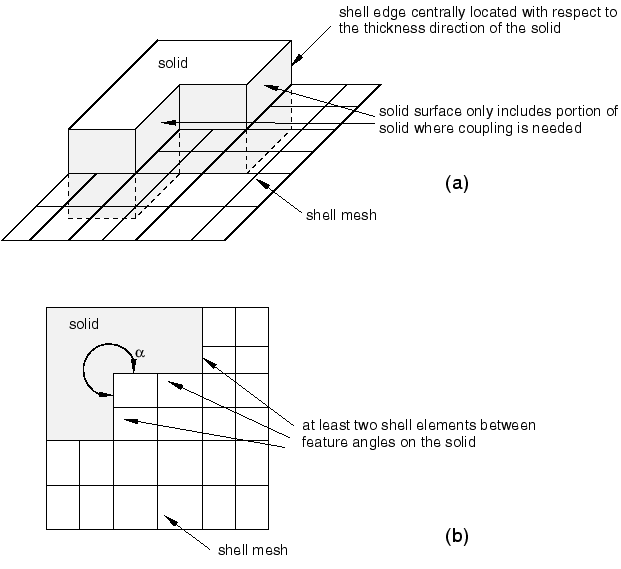Shell-to-Solid Coupling
Shell-to-solid coupling in Abaqus is a surface-based technique for coupling shell elements to solid elements. Figure 1 illustrates two examples taken from Shell-to-solid submodeling and shell-to-solid coupling of a pipe joint and The pinched cylinder problem. Shell-to-solid coupling is intended to be used for mesh refinement studies where local modeling requires a relatively fine through-the-thickness solid mesh coupled to the edge of a shell mesh, as shown in Figure 2. In such a case Abaqus assembles constraints that couple the displacement and rotation of each shell node to the average displacement and rotation of the solid surface in the vicinity of the shell node.


As shown in Figure 2, the coupling occurs along a shell-to-solid interface defined by two user-specified surfaces: an edge-based shell surface and an element- or node-based solid surface (see About Surfaces). The shell surface (Figure 3) is referred to as the “shell edge.”

The shell element edges that define the edge-based shell surface are referred to as “edge facets.” The edge facets are either linear or parabolic segments depending if the underlying shell elements are linear or quadratic.
The shell-to-solid coupling is enforced by the automatic creation of an internal set of distributing coupling constraints (see Coupling Constraints) between nodes on the shell edge and nodes on the solid surface. Abaqus uses default or user-defined distance and tolerance parameters (discussed below) to determine which nodes on the shell edge will be coupled to which nodes on the solid surface. For each shell node involved in the coupling, a distinct internal distributing coupling constraint is created with the shell node acting as the reference node and the associated solid nodes acting as the coupling nodes. Each internal constraint distributes the forces and moments acting at its shell node as forces acting on the related set of coupling surface nodes in a self-equilibrating manner. The resulting line of constraints enforces the shell-to-solid coupling.


